Blog
Pink purslane
Claytonia sibirica is not a native plant here, it comes from North America, but in recent years you see it more often in the woods. It doesn't (yet) spread enough to be a problem, but it is enough to be spectacular in places for the passing mountain biker.

Wild strawberry
It has been a while since I wrote a mountain biking blog. That isn't because I haven't been out cycling in the woods, I've been out most days during lockdown (the advantage of flexible working hours working from home). I suppose it came down to nothing much to write about. However, Spring is here, and I can resume my Botanical Mountain Biking series. Last year I did a few articles with several photos in them. In the coming period I'm going to post the photos individually as I join in. If you also see interesting plants whilst out cycling feel free to post photos of them (ideally with your bike in the background) on social media with the hashtag #BotanicalMountainbiking.

Botanical Mountain Biking part 2 - late summer and autumn
During the pandemic I've been doing quite a lot of cycling on my own in the woods near to Wageningen. Earlier this year, I discovered that a great way to liven up the rides is to try and look out for a new plant to photograph every time. As we got into summer and then autumn, that got progressively harder. In August, there was still quite a lot in flower, like the Galium mollugo in the photo below, but by September it was definitely getting more difficult. The Galium is a nice example of a tiny flower which normally you might not give a second glance to, and might even look a bit scruffy, but in close up has an exquisite beauty.

As the autumn arrived, we were treated to an incredibly large amount of fruits from trees and shrubs like beech, oak and hazel (the photo below). Actually that photo is a bit of a cheat because it was taken in my garden, but it is a native plant that found its own way there. Although trees like the oak do have some acorns every year, every few years it is a 'mast year' and they have large numbers of nuts. The evolutionary advantage is that in those years they produce so much food that animals like wild boar and jays cannot manage to eat them all, so there will be some left over to make seedlings. If they did that every year, it would be too big a drain on resources and also the animal populations would just increase in size until they could eat all the acorns. 'Mast' in this sense is derived from an Old German word meaning food, and the Dutch word is the same.

Once the spring and summer flowers were finished, it got harder to find a new species each ride. That means that I had to turn my attention to groups like grasses and rushes. When cycling past a rush plant, even at the moderate pace that I tend to go at, it is not so easy to see what the species is and I'm 100 meters past it by the time I've had a chance to think about it. However, seeing a lot of my rides have, by necessity, been along much the same tracks, I developed the trick of making a mental note of where something looked interesting and then going that way the next day. The rush below was a good example of that. It turned out to be Juncus tenuis. That is a species which is native to North America and wasn't found here (in Holland) until 1821. Nowadays it is not uncommon and typically found in open dry disturbed areas like in the photo below.

Although the autumn doesn't have so many flowers, there has been plenty of spectacular oranges and reds this year. The American Oaks which are abundant in parts of the woods here have been especially impressive.

Modern botanists don't count fungi as plants, having given them a kingdom of their own, but back in the Dark Ages when I was a student, they still counted as plants. This autumn the toadstools were a little late coming, due to the drought, but once they came we had a lot. Oudemansiella mucida (= Mucidula mucida) is called porcelain fungus in English (and in Dutch as well), for obvious reasons when you look at the photo below. When I was taking the photo a little girl came up and said how pretty it was. Her father then came up and commented that the fungus was nice, but that he thought that my bike looked even better!

Most of the trees in the woods near here are relatively young. However, every so often I come across an old one like the Beech below, with a huge girth, which was growing next to the Amerongen mountain bike route. Very impressive and it had incredible textures on the bark.

As the autumn comes to an end and winter comes on, it is going to be considerably harder to keep up finding a new species each ride. A challenge!
Botanical Mountain Biking
Throughout the period of the lockdown, from the strict beginnings, to the more relaxed regimes now (early August), we have been fortunate here in the Netherlands, that we have been allowed out to exercise the whole time. After a day sitting at my desk in my home office I have certainly been ready to get out on my bike, so that means that most days I have been out appreciating the woods nearby. In order to add a bit of extra interest, I have tried to take a photo of a different plant in flower each evening. I have been at it several months and so far not running out of flowers. Here are a few examples.
Viola oderata is known in Dutch as March Violet and indeed this photo was taken back in March. That time of the year, one of the joys of being out on your bike is seeing all the fresh spring flowers coming out one after the other.
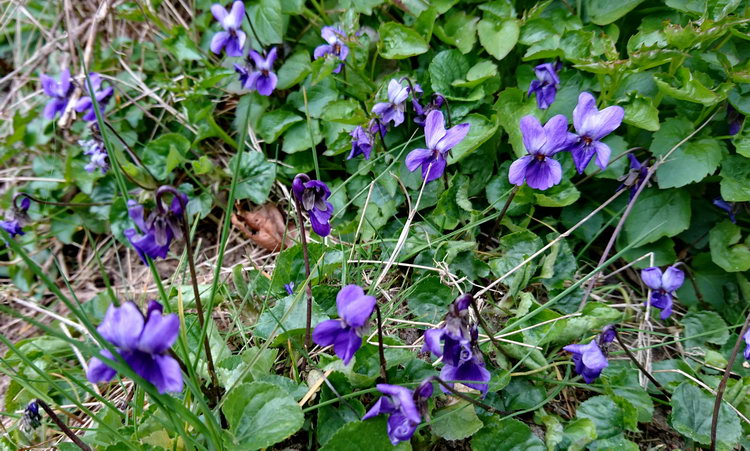
On the dry sandy grounds around here, there are not a lot of rare plant species, but one which is quite special is Maianthemum bifolium. In the UK, where I grew up, it is incredibly rare, only being found in a very few places. I still remember the excitement of seeing it for the first time, growing on the Veluwe. In the Netherlands, it is on the edge of its distribution; further to the West it becomes more common.
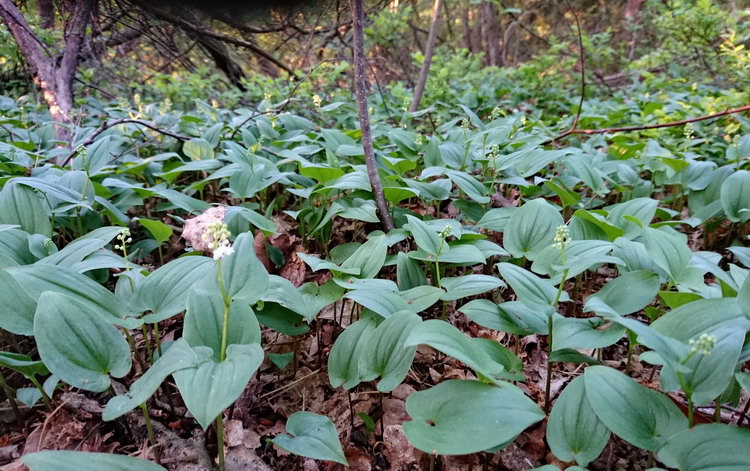
Some wild flowers are as spectacular as the garden varieties. The native Iris, Iris pseudacorus, grows with its feet in water and it is every bit as beautiful and elegant as a tropical orchid.
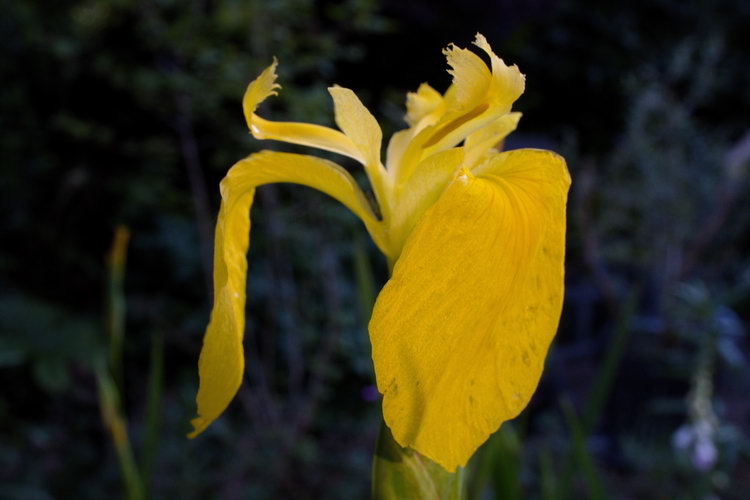
A lot of wild plants look quite unassuming until you take a close look. Not always so easy to do if you are whisking by at high speed on your mountain bike, or even if you trundle by at the speed I usually go at. That means that it is easy to think that there are not so many different species around, as they can look the same at first glance. These two Rumex species (sanguineum on the left and obtusifolius on the right) look much the same from a distance, but their fruits look entirely different in close-up. However, mountain bikers really need to know what Rumex obtusifolius looks like, because it is the one which you can rub on a nettle sting. When I was a student, my lecturer in organic chemistry told me that he had isolated a chemical which he called rumexin from their leaves, and discovered that it is in fact a mild local anaesthetic.
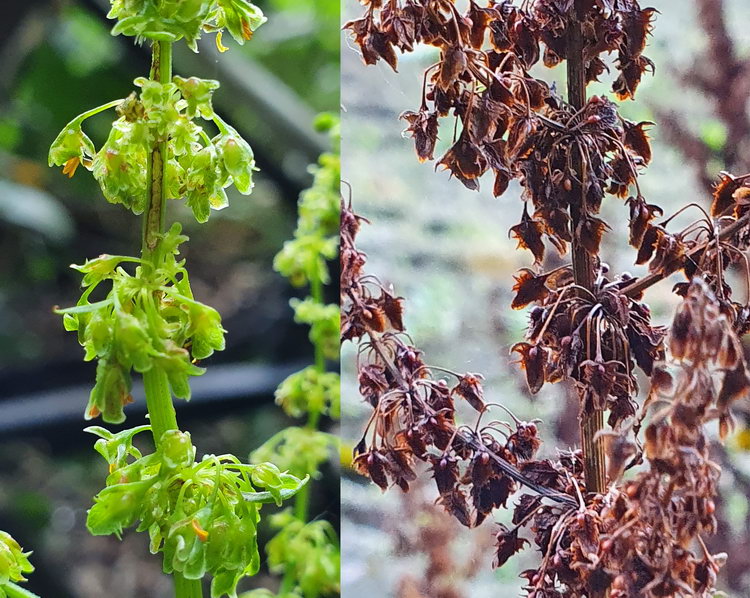
Another group of plants which bears closer inspection is the mosses. After it has rained, which brings out their lovely fresh greens, they can look wonderful carpeting the forest floor, but if you look closer, then they can also be fascinating. The one below is called Rhitidiadelphus squarrosus, in Dutch hook moss ('haakmos') because of the form of its shoot tips.
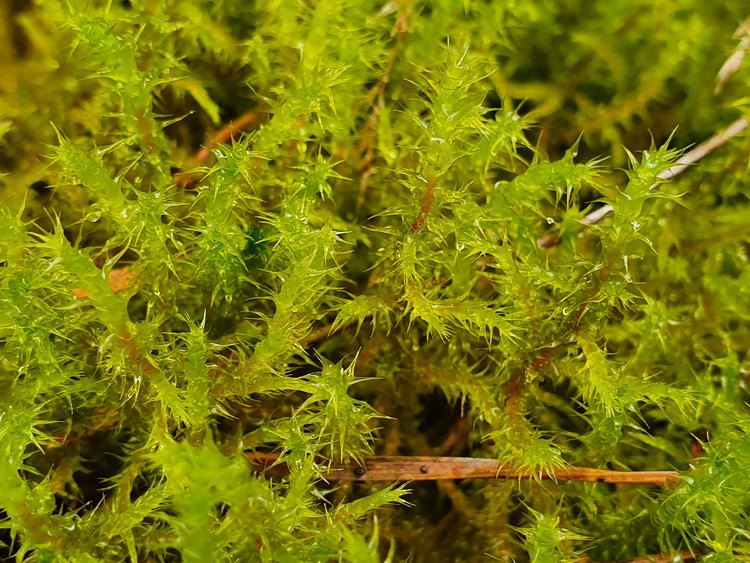
Plants are a part of the landscape and help form that landscape. Which plants grow in any given place is determined by all sorts of factors, and that changes with time. The grass that you see dominating the landscape below, Molinia caerulea, has become much more abundant round here than in the past. The intensive agriculture and other sources of pollution has led to a lot of nitrogen pollution in the air and rain, and that acts as a fertilizer. Grasses respond to that by growing more vigorously and other plants like heather not only don't grow better, but also can be more susceptible to pests and diseases. Unfortunately, knowledge of those processes can spoil your appreciation of what would otherwise be just a beautiful wild landscape.
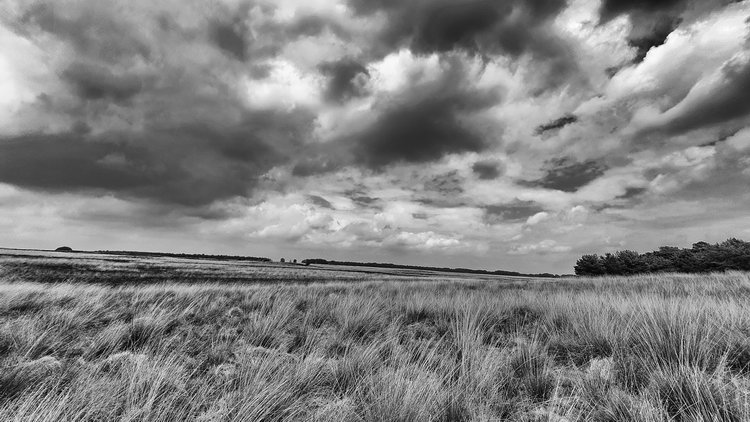
But that isn't always the case. Sometimes knowledge of the ecology helps appreciation of what you see. Melumpyrum pratense is flowering along the edges of the paths in the woods at the moment. It is a hemiparasite, which means that it depends on part on other plants for its sustenance. In the books it says that this can be a variety of different plants, but in practice, if you see it flowering, I guarantee that if you look up, you will see the canopy of an oak tree above it. The Melumpyrum depends on the oak and (I guess) it is small enough that it won't do the oak any harm. A nice example of the interdependence of all life.
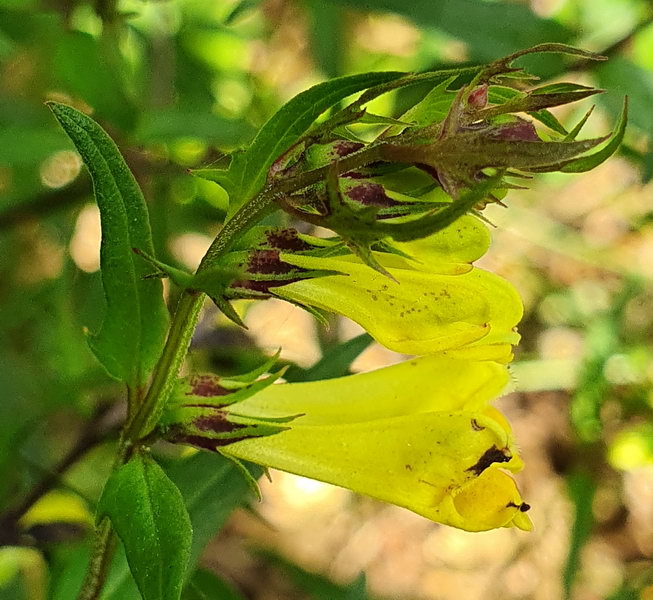
Nijmegen Red Route Renewed
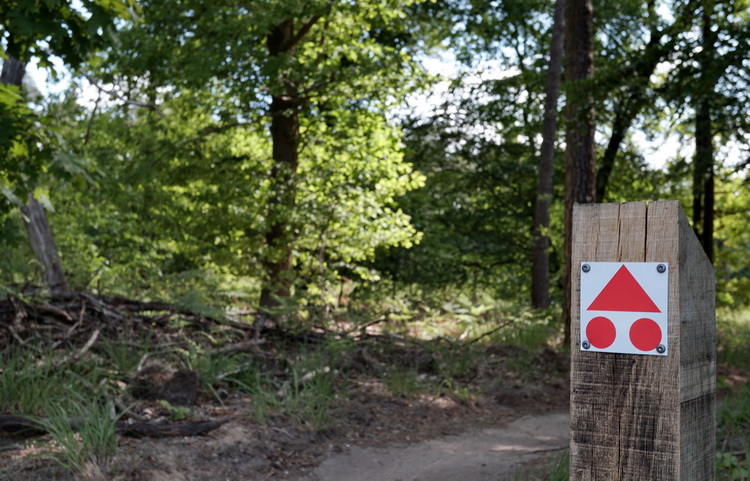
The red route by Nijmegen has been renewed over the winter, so last weekend I took myself off in that direction to see what it was like. The starting point in Berg en Dal is not so far from Wageningen, so I thought I would cycle from home and then just do the red route. That was all very well, but unfortunately when I asked the cycling route planner for the best way to go from my 'current location' to the start, my computer took it into its head that I was currently in Oosterbeek. Oosterbeek is about half an hour cycling from Wageningen, so that meant I ended up cycling an hour longer than planned. Fortunately it was beautiful weather so that wasn't such a problem.
[Text continues under the photo]
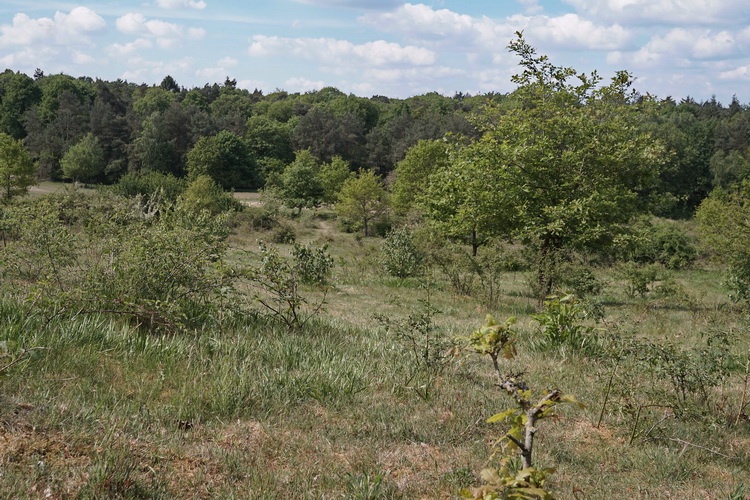
Anyway, it was definitely worth it. The old route was one that I always enjoyed cycling, but it had been much more improved. The beautiful woodland and spectacular views (above) are still there. It has more up and down (it certainly felt like more than the 350m registered) and much more twisty and fun. Definitely hard work. It was quite busy, with a lot of mountain bikers. I had read various horror stories about large numbers of people without proper cycling clothing (not such a problem) and without helmets (big problem) and with too little skills and experience for the track (also not so handy). Apparently the lockdown had prompted some people to try mountain biking for the first time, seeing alternative forms of recreation like shopping have been restricted. Something to be applauded of course, but not without helmets. Perhaps that was more of a problem a few weeks ago, because last weekend although there were definitely some beginners (which I was happy with, at least I wasn't the slowest person on the trail), they all had helmets and were taking things reasonably cautiously.
Bottom line, they've made a good route better and I definitely want to see what the Green (Groesbeek) Route looks like now.
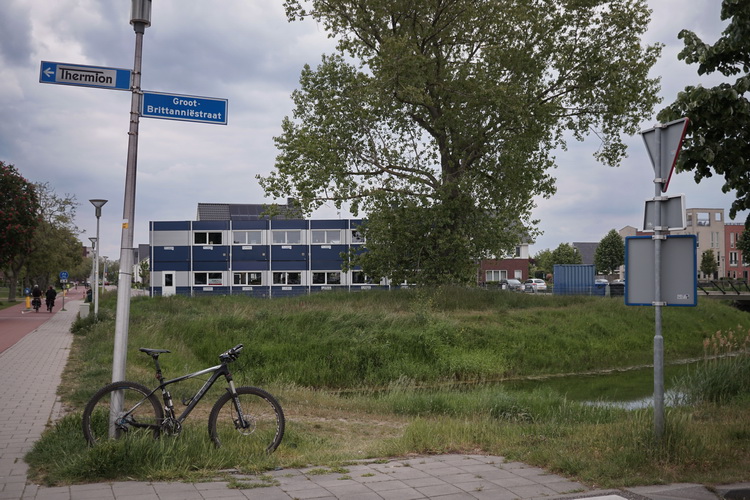
Above: Personalized return route (see the street name)
Mountain biking in the time of Corona Part 2
Normally I cycle into work, but seeing we're all working from home, that's not happening any more. Fortunately we are still allowed out on our bikes here, so long as we keep 1.5 m from anyone else and only with your own household or alone. So every day I have been out on my bike a bit, but sticking to cycle paths, not off-road. The photos below are one from each day of last week.
This week we have had amazing weather, with blue skies and cold nights. Here you can see how the light brings out the shapes of this avenue of beech trees.
[Text continues under photo]

Spring is definitely on the way. This Coltsfoot flower is always a sure sign that winter has come to and end and is a joy to see. It looks superficially like a dandelion but the scales running up its flower-stalk are quite distinctive.
[Text continues under photo]

I have discovered that a good time to go out for my exercise is early evening, when many people are still eating or putting the children to bed. That has also meant seeing some spectacular sunsets in the last few days. Note the complete absence of aircraft vapour trails! Going at that time also has the advantage that it is deserted everywhere. Although everyone does their best to cycle at the opposite edge of the cycle path when you meet them, it is still easier if that isn't necessary.
[Text continues under photo]

The Binnenveld is an area to the west of Wageningen which has recently had a large area converted from farmland to nature reserves. Last week the water levels were high and it was full of all sorts of wading birds, especially oystercatchers and lapwings (or peewits as we used to call them). However, after a week of no rain at all it is all drying out and the waders were mostly gone. This small lake (or large pond) still had plenty of birds though.
[Text continues under photo]

The photo below was taken in the middle of the day on what is usually a reasonably busy road. Not a car or bike to be seen!
[Text continues under photo]

Today it is Saturday and there was time to go mountain biking for a few hours rather than just a quick ride on the road as it got dark. Aside from not transmitting deadly diseases to your club-mates, mountain biking by yourself has a couple of other advantages. Firstly, you can take a flask of coffee to drink on the way. And secondly, you see a lot more wildlife. In addition to the cowslips below, this morning I saw a couple of storks (really close and not bothered by me), a hare and all sorts of other birds.
This evening the clocks go forward and it will be lighter in the evening. Unless there is a tightening of the regulations, cycling off-road in the evenings should then be possible!

